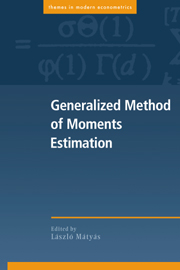Book contents
- Frontmatter
- Contents
- Contributors
- Preface
- 1 Introduction to the Generalized Method of Moments Estimation
- 2 GMM Estimation Techniques
- 3 Covariance Matrix Estimation
- 4 Hypothesis Testing in Models Estimated by GMM
- 5 Finite Sample Properties of GMM estimators and Tests
- 6 GMM Estimation of Time Series Models
- 7 Reduced Rank Regression Using GMM
- 8 Estimation of Linear Panel Data Models Using GMM
- 9 Alternative GMM Methods for Nonlinear Panel Data Models
- 10 Simulation Based Method of Moments
- 11 Logically Inconsistent Limited Dependent Variables Models
- Index
7 - Reduced Rank Regression Using GMM
Published online by Cambridge University Press: 04 February 2010
- Frontmatter
- Contents
- Contributors
- Preface
- 1 Introduction to the Generalized Method of Moments Estimation
- 2 GMM Estimation Techniques
- 3 Covariance Matrix Estimation
- 4 Hypothesis Testing in Models Estimated by GMM
- 5 Finite Sample Properties of GMM estimators and Tests
- 6 GMM Estimation of Time Series Models
- 7 Reduced Rank Regression Using GMM
- 8 Estimation of Linear Panel Data Models Using GMM
- 9 Alternative GMM Methods for Nonlinear Panel Data Models
- 10 Simulation Based Method of Moments
- 11 Logically Inconsistent Limited Dependent Variables Models
- Index
Summary
Since the mid eighties, alongside the literature arising on GMM, a large number of papers emerged on cointegration as well. This is due to the fact that cointegration models combine two features which many economic time series possess, i.e., random walk individual behavior and stationary linear combinations of multiple series.
Cointegration models are essentially linear models with reduced rank parameters. The reduced forms of the traditional simultaneous equation models have also this reduced rank property (see Hausman [1983]). The estimation techniques used in cointegration and simultaneous equation models are therefore very similar. Maximum likelihood estimators for both models use, for example, canonical correlations, (see Anderson and Rubin [1949] and Johansen [1991]), and maximum likelihood reduced rank regression therefore amounts to the use of canonical correlations and vectors. This chapter shows that GMM reduced rank regression amounts to the use of two stage least squares (2SLS) estimators. The asymptotic properties of the 2SLS estimators used in simultaneous equation models are in general identical to the properties of maximum likelihood estimators (see, for example, Phillips [1983]). This chapter shows that this also holds for cointegration models. Furthermore, the GMM objective function has asymptotic properties which are identical to a likelihood ratio statistic for cointegration, the Johansen trace statistic (Johansen [1991]), and it can thus be used in a similar way. The similarities between GMM and maximum likelihood estimators in reduced rank models are therefore quite large. The GMM, however, also allows for the derivation of the asymptotic properties in the more complex reduced rank models, which is not true for the maximum likelihood estimators.
- Type
- Chapter
- Information
- Generalized Method of Moments Estimation , pp. 171 - 210Publisher: Cambridge University PressPrint publication year: 1999



